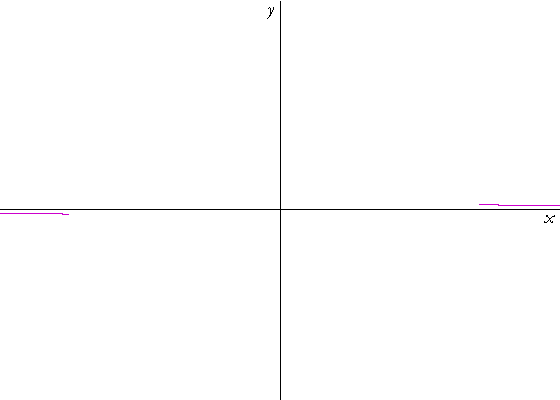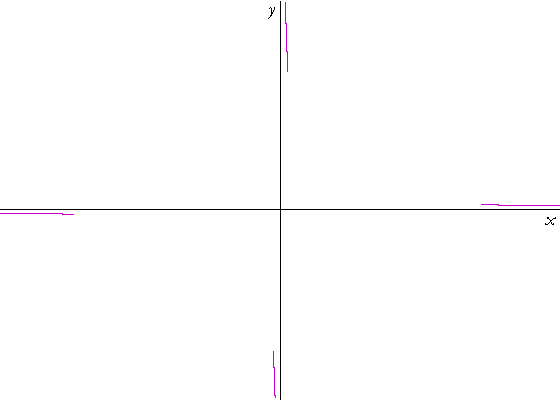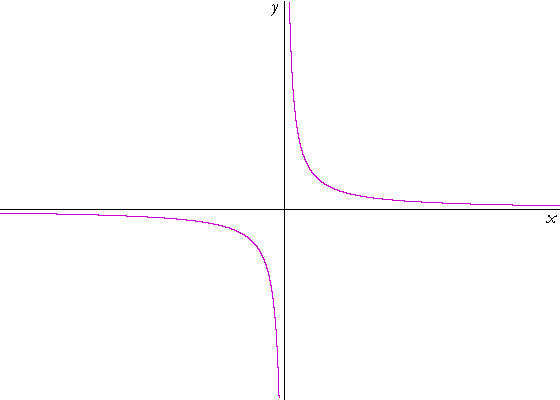18
RATIONAL FUNCTIONS
A RATIONAL FUNCTION is a quotient of polynomials. It will have this form
| y = | g(x) h(x) |
, |
where g and h are polynomials (h ![]() 0).
0).
A rational function will have an x-intercept -- y will equal 0 -- only if the numerator g(x) = 0. Consider, for example,
| y = | 1 x − 8 |
. |
Since the numerator 1 will never be 0, the graph of this function never touches the x-axis.
| Now a denominator may never be 0. The symbol | 1 0 |
has no meaning. |
| Therefore, in the rational function | 1 x − 8 |
, x may not have the value 8. |
8 is called a singularity of that function.
A singularity of a function is any value of x that would make a denominator 0.
Problem 1. In each of the following, which values of x may not be included in the domain? That is, which values are the singularities of the function?
To see the answer, pass your mouse over the colored area.
To cover the answer again, click "Refresh" ("Reload").
| a) y = | 1 x |
x = 0 | b) y = | 1 x + 5 |
x = −5 | c) y = | 1 2x + 1 |
x = −½ |
| d) y = | 1 x² − 16 |
x = 4 and −4 | e) y = | 1 x² + x − 6 |
x = −3 and 2 |
The reciprocal function
We are now going to look at the function
| y = f(x) = | 1 x |
This is called the reciprocal function. (It is also the equation of a hyperbola, which, like the parabola, is one of the conic sections.) We are going to see how to draw the graph. We will ask -- and answer -- the following questions. The student should understand that these same questions must be answered when drawing the graph of any rational function.
1. Is the graph symmetrical with respect to the y-axis or to the
1. origin?
We must look at f(−x):
| f(−x) = | 1 −x |
= − | 1 x |
= − | f(x). |
f(−x) = −f(x). Therefore, the graph is symmetrical with respect to the origin. Hence, we need only draw the right-hand side. The left side will follow from the symmetry.
2. Are there any x- or y-intercepts?
| Can we solve y = | 1 x |
= 0 ? |
No, we cannot, because the numerator 1 is never 0. (Lesson 6 of Algebra.) Therefore there are no x-intercepts. And x may not be 0. Therefore, there are no y-intercepts, either.
3. What happens to the value of y when x is very large?
| y = | 1 x |
If x is a very large positive number, then y will be a very small positive number. This means that when we are at the extreme right end

of the x-axis, the height of the graph -- the value of y -- will be very close to the x-axis, and on the positive side:
4. Where is the singularity of this function?
At x = 0.
5. What happens to the value of y when x is close to a
5. singularity?
y becomes extremely large:

When x is close to 0 in this case -- when x is a very small positive number -- then y, its reciprocal, will be a very large positive number.
Now, we know that there are no intercepts. And x will take every value greater than 0. Therefore, those two ends of the graph must
| connect. Here is the graph of y = | 1 x |
: |

Asymptotes
Briefly, asymptotes are lines that come closer and closer, but never meet.
The x-axis is a horizontal asymptote of that graph. The graph and the x-axis come closer and closer, but never touch.
In general,

"The horizontal line y = b is a horizontal asymptote of the graph of
y = f(x)" means: There will be a large value of x -- call it x0 -- such that the distance between f(x0) and b -- and all subsequent values of |f(x) − b| -- will be smaller than any small number we might name.
In other words, the distance between the graph and the horizontal asymptote becomes virtually 0.
The y-axis is a vertical asymptote of that graph.
In general,

"The vertical line x = a is a vertical asymptote of the graph of
y = f(x)" means: There will be a value of x close to a -- call it x0 -- such that f(x0) and all values of f(x) closer to a, will be larger than any large number we might name.
That is, at values of x close to a singularity -- when the denominator is a very small number, almost 0 -- the value of the function becomes an extremely large number.
Where, then, do we always find a vertical asymptote of a graph?
At a singularity.
Problem 2. Write the equation of the vertical asymptote(s) of each of the following.
| a) y = | 1 x |
x = 0 | b) y = | 1 x + 5 |
x = −5 | c) y = | 1 2x + 1 |
x = −½ |
| d) y = | 1 x² − 16 |
x = 4 and x = −4 |
| e) y = | 1 x² + x − 6 |
x = −3 and x = 2 |
Problem 3. Each of the following is a translation or transformation of
| y = | 1 x |
. Sketch the graph of each one. |
| a) y = | 1 x − 3 |

| b) y = | 1 x + 2 |

| c) y = − | 1 x + 2 |

This is a reflection about the x-axis of graph b).
| d) y = | 1 x − 3 |
+ 2 |

www.proyectosalonhogar.com
